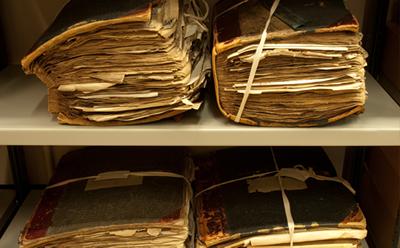Contact Us
Please contact us if you have any questions about the collection.
The letter books of the secretary of the Board of Guardians for the Relief of the Jewish Poor form part of the collection MS 173 Archives of Jewish Care. Catalogues for each of the letter books can be downloaded from the useful downloads section below.

Board of Guardians for the Relief of the Jewish Poor, more commonly known as the Jewish Board of Guardians, was established in 1859 by representatives of the three main London synagogues - the Great Synagogue, the Hambro’ Synagogue, and the New Synagogue. They were charged to constitute a Board of Guardians for relief of poor Jewish immigrants, referred to as the 'strange poor', living in London. Almost immediately after its formation the Board began to extend both its scope and revenues, and soon became the chief source of support for poor Jews in the city. The Board helped to keep Jews away from the English Poor Law, with the burden of maintaining their poor falling almost entirely on the Jewish community.
The letter books of the secretary consist of eight volumes containing correspondence, reports, press cuttings, financial statements, and other papers relating to the activities of the Board from the early 1880s to the mid-1940s. These materials reflect the transformative nature of the Board, which continually adapted its activities to meet changing conditions and needs. The Board achieved this through a range of committees and sub-committees as well as coordinated efforts with other charitable organisations and institutions.
They primary activity of the Board was the administration of poor relief. Investigating officers, working alongside the Investigating Committee (later the Fixed Allowance and Temporary Allowances Committees), were responsible for investigating each case. Relief was then provided either monetarily, through fix or temporary allowances, or through the distribution of tickets for relief supplies.
While the Investigate Committee was responsible for the provision of ordinary relief work, the Loan Committee was responsible for the granting of loans. Loans acted as a preventative measure to stop struggling tradesmen or families from falling into pauperism. The Emigration Committee, on the other hand, was responsible for providing financial assistance for emigration, with the majority of cases assisted in travelling either to the United States or Australia, or in returning to Europe.
Almshouses were the first set of institutions controlled by the Board and were administered by the Almshouses Committee. These included the Jacob Henry Moses Almshouses, Joel Emanuel Almshouses and Moses and Solomon Almshouses.
The activities of the Industrial Committee focused on the training of apprentices and the running of the Board’s workrooms, where girls were taught dressmaking and embroidery. Medical relief was provided through the Sanitary Committee (later the Health Committee) with activities including conducting health visits and sanitary inspections, the latter involving investigating and reporting on the sanitary condition of the homes of the poor. From the 1920s the health work of the Board focused primarily on the administration of convalescent homes with the Health Committee becoming the Health and Convalescent Committee. Convalescent homes run by the Board included the Anthony and Annie Muller Convalescent Home at Broadstairs, the Clara Baroness de Hirsch Convalescent Home at Hampstead Heath, the Convalescent Home for Boys at Hove, the Gerald Samuel and Denzil Myer Home for Orphan Boys in Stepney, the Samuel Lewis Seaside Convalescent Home at Walton-on-the-Naze, and the Zachary Merton Convalescent Home at Grayshott.
The Board was a philanthropic endeavour and was both established and run by prominent members of the Jewish community. In addition to materials reflecting the activities of the Board’s various committees and associated institutions, there is a significant portion of materials relating to the individuals responsible for the running of the Board. This includes correspondence dealing with the appointment and resignation of both members of the Board and its committees, as well as representatives of the Board at other public bodies. Financing of the Board was also dependent on the generosity of members of the Jewish community with a significant portion of materials relating to the provision of donations and contributions, particularly in the form of legacy bequests.
The collection includes a small number of case materials. The majority of these date from the 1880s to the early 1900s and primarily relate to cases of deserted children. These include cases of children being removed from workhouses and placed in the care of Jewish families or Jewish institutions, in particular the Jews’ Hospital and Orphan Asylum in Norwood. The Board also assisted the emigration of children in cases where they could be reunited with their parents.
There is a significant number of material relating to the Board’s provision of financial assistance for emigration. This resulted in tensions with authorities in the United States and is reflected in correspondence with the United Hebrew Charities in New York in the early 1900s. Likewise, tensions regarding the arrival of Jewish refugees into Britain are particularly evident in materials relating to Board’s efforts to facilitate refugees from Transvaal arriving in Southampton, en route for Europe, during the Second Boer War.
Each of the eight volumes of the secretary’s papers contain between one hundred and three hundred pages, with a large number of items attached to each page in a series of folded bundles. While the items are arranged in a general chronological order, the volumes do not contain any form of index. As such, the catalogues for the collection provide item level descriptions.
The letter books are complimented by a range of Jewish Board of Guardians materials that form part of the Archives of Jewish Care. Together these materials offer a deep insight into the activities of this pioneering Jewish charity, with its ability to adapt to the development of statutory welfare services and to meet changing social and economic conditions from the late nineteenth to the mid-twentieth century.
Please contact us if you have any questions about the collection.
Find out how to book an appointment to view the collection.
Learn about our image copying service.